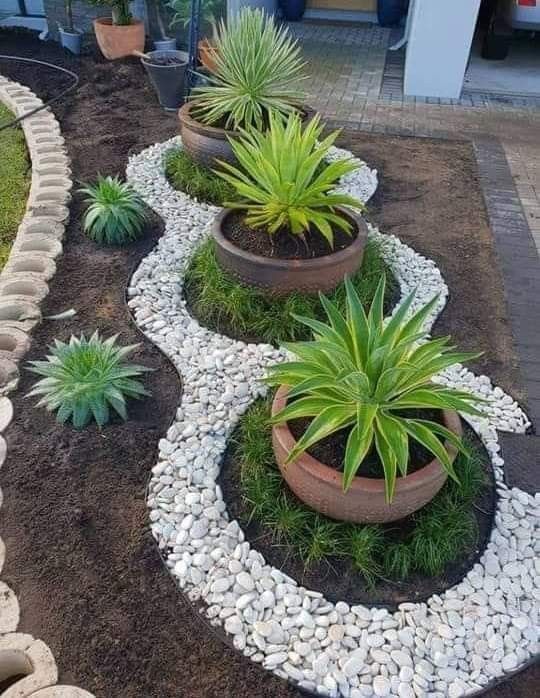Are you wondering how to design a vegetable garden layout in row planting? Row planting is a popular method for organizing and maximizing space in a vegetable garden.
In this article, we will explore the ins and outs of row planting, including selecting the right location, choosing the best vegetables, planning and measuring your garden space, creating straight rows, proper spacing and depth for planting, maintenance and care, maximizing yield and harvest, as well as tips for success in designing and managing a row-planted vegetable garden.
When it comes to designing a vegetable garden layout, row planting offers an efficient way to utilize space while ensuring proper sunlight exposure and airflow for your crops. Whether you are a beginner or experienced gardener, mastering the art of row planting can greatly enhance the productivity of your vegetable garden.
Row planting involves arranging your vegetables in straight lines or rows rather than in scattered clusters. This approach not only makes it easier to navigate through the garden but also aids in efficient irrigation, fertilizer application, and pest control. Additionally, it allows for better organization when it comes to harvesting time. In the following sections, we will delve deeper into various aspects of row planting that will help you create a productive and visually appealing vegetable garden.
Selecting the Right Location for Your Vegetable Garden
- Sunlight: Ensure that your garden plot receives at least 6-8 hours of direct sunlight each day. Most vegetables thrive in full sunlight, so it’s important to select a location with ample exposure to the sun.
- Soil Quality: The quality of the soil is essential for the healthy growth of vegetables. Conduct a soil test to determine the pH level and nutrient content of the soil in your chosen location. Ideally, you want loamy, well-draining soil with a pH level of 6.0-7.0 for optimal vegetable growth.
- Accessibility to Water: Access to water is another crucial factor when selecting a location for your vegetable garden. Ensure that your garden plot is easily accessible to a water source, whether it’s through irrigation or manual watering.
- Protection from Wind and Pests: Choose a location that offers some natural protection from strong winds and potential pests. Consider planting near a fence or natural windbreaks to shield your vegetables from harsh weather conditions.
By carefully considering these factors when selecting the right location for your vegetable garden, you can ensure that your row-planted vegetables will thrive and produce a bountiful harvest.
Choosing the Best Vegetables for Row Planting
When it comes to row planting in a vegetable garden, choosing the right vegetables is essential for a successful harvest. Different types of vegetables have different requirements when it comes to spacing, sunlight, and water, so it’s important to select varieties that are well-suited for row planting.
Consider the Size and Growth Habits
When choosing vegetables for row planting, consider the size and growth habits of each type. Some vegetables, such as tomatoes and cucumbers, require a lot of space to spread out, while others, like carrots and lettuce, can be planted closer together. Take into account the mature size of each plant and ensure that they will have enough room to grow without crowding each other.
Choose Complementary Vegetables
Selecting complementary vegetables is also important when designing a row-planted garden. Certain plants can benefit from being grown together, either through natural pest control or by improving the soil. For example, planting onions alongside carrots can help deter carrot flies. Similarly, planting beans near corn can provide support for climbing beans while fixing nitrogen in the soil for the corn.
Match Vegetables With Your Growing Zone
It’s crucial to choose vegetables that are well-suited for your specific growing zone. Consider the average temperature, sun exposure, and climate conditions in your area when selecting which vegetables to plant. Some crops may thrive in cooler temperatures and others in warmer climates, so be sure to do your research on which vegetables are best suited for your region.
By carefully selecting the best vegetables for row planting based on their size, growth habits, compatibility with other plants, and suitability for your specific climate zone, you can set yourself up for a successful and bountiful vegetable garden.
Planning and Measuring Your Garden Space
When it comes to designing a vegetable garden layout using row planting techniques, planning and measuring your garden space is crucial. Properly organizing and utilizing the available space will help ensure that your vegetables have enough room to thrive and grow. Here are some steps to consider when planning and measuring your garden space:
- Assess the available space: Before you start planting, take the time to assess the area where you plan to create your vegetable garden. Consider factors such as sunlight exposure, soil quality, and access to water sources.
- Determine the layout: Decide on the layout of your garden based on the space available. Whether you choose a traditional straight-row approach or opt for raised beds, make sure to measure and map out the different sections of your garden.
- Consider crop rotation: When planning your garden space, take into account the concept of crop rotation. This practice involves changing the location of crops each year to improve soil quality and reduce disease buildup. Plan for multiple growing seasons by incorporating this technique into your garden layout.
Taking the time to plan and measure your garden space before planting will set you up for success in creating a productive and efficient vegetable garden using row planting techniques. By carefully considering factors such as sunlight, soil quality, layout, and crop rotation, you can maximize the use of your available space while promoting healthy growth for your vegetables.
Creating Straight Rows for Planting
Once you have selected the right location for your vegetable garden and chosen the best vegetables for row planting, the next step is to create straight rows for planting. Straight rows not only make your garden look organized and neat, but they also make it easier to water, weed, and harvest your crops.
To create straight rows for planting, start by marking the row lines with stakes and strings. Use a tape measure to ensure equal spacing between the rows, usually about 18-24 inches apart, depending on the specific needs of the vegetables you are planting. Use a hoe or a shovel to dig a small trench along the marked line to help guide you as you plant your seeds or seedlings.
Another technique for creating straight rows is using a garden bed rake or a string line level to ensure that the rows are perfectly even. A string line level is an inexpensive tool that consists of a string and small levels that can be used to determine if a surface is level or straight.
Place wooden stakes at each end of your row and stretch the string taut between them at ground level. Adjust the string until it is perfectly straight and then use it as a guide for planting your seeds.
Properly aligned rows will not only make your vegetable garden visually appealing but also make it easier to manage in terms of watering, weeding, and harvesting throughout the growing season.
| Row Planting Technique | Benefits |
|---|---|
| Using stakes and strings | Makes it easier to water, weed, and harvest crops |
| Garden bed rake or string line level | Ensures perfectly even rows for easy management |
Proper Spacing and Depth for Planting
When it comes to row planting in a vegetable garden, proper spacing and depth for planting are crucial for the success of your crops. Each vegetable has its own specific spacing and depth requirements, so it’s important to research and plan accordingly. The right spacing ensures that each plant has enough room to grow and receive the necessary nutrients, water, and sunlight. Additionally, planting at the correct depth helps the plants establish strong roots and thrive in their environment.
One important aspect of proper spacing is avoiding overcrowding. Crowded plants compete for resources and may become more susceptible to diseases or pests. It’s also essential to consider mature plant size when determining spacing, as larger plants will need more room to spread out.
Depth for planting varies by vegetable, with some seeds needing to be sown shallowly while others require deeper placement in the soil. Understanding these requirements can make a significant difference in the overall health and productivity of your garden.
| Vegatable | Spacing (Inches) | Planting Depth (Inches) |
|---|---|---|
| Lettuce | 8-12 | 1/4-1/2 |
| Tomatoes | 24-36 | 24-36 |
| Zucchini | 36-48 | 1 |
Maintenance and Care for Row Planted Vegetables
Regular Weeding and Watering
Once your vegetables are planted in rows, an important part of maintenance is keeping the garden free from weeds. Weeds can compete with your vegetables for nutrients, so regular weeding is necessary to ensure a healthy garden. Additionally, proper watering is crucial to the health of your row-planted vegetables. Make sure to water the rows deeply and consistently, especially during dry periods.
Pest and Disease Management
Another aspect of caring for row-planted vegetables is to monitor for pests and signs of disease. Some common pests that can affect vegetable plants include aphids, caterpillars, and snails. To prevent these pests from causing damage to your crops, consider implementing natural pest control methods or using organic pesticides.
Additionally, keep an eye out for any signs of disease such as wilting, yellowing leaves, or unusual spots. If you notice any issues, take action promptly to prevent the spread of disease throughout your garden.
Supporting Tall Vegetables
For tall row-planted vegetables like tomatoes or peas, providing support is essential to prevent them from bending or breaking under their own weight. Staking or trellising these plants will help keep them upright and make it easier for the fruits to develop without touching the ground. When planning your row layout, take into account the need for support structures for certain types of vegetables.
Maximizing Yield and Harvest With Row Planting Techniques
Row planting in vegetable gardens is not only a great way to maximize space, but it also allows for easier maintenance and care. To further optimize your yield and harvest, there are specific techniques that can be employed when utilizing row planting in your garden.
One technique for maximizing yield and harvest with row planting is the use of companion planting. This involves planting certain vegetables together that benefit each other in some way, such as deterring pests or providing nutrients to the soil. For example, planting basil alongside tomatoes can help repel pests that commonly affect tomato plants. Researching which vegetables work well together and implementing this technique can result in healthier plants and a greater harvest.
Another technique to consider when row planting is succession planting. This involves sowing seeds or transplanting seedlings at regular intervals throughout the growing season to ensure a continuous harvest. By staggering plantings, you can make the most of your garden space and extend your harvest window, leading to a greater overall yield. This technique requires planning and careful attention to timing, but it can significantly increase the productivity of your vegetable garden.
In addition, using mulch in between rows can help maximize yield by suppressing weeds, retaining moisture, and regulating soil temperature. Mulching also helps prevent soil erosion which can damage young plants and reduce overall yield.
There are various types of mulch available, such as straw, wood chips, or compost, so you can choose the best option for your specific garden needs. Implementing these row planting techniques can help you get the most out of your vegetable garden and enjoy a bountiful harvest throughout the growing season.
Tips for Success in Designing and Managing a Row-Planted Vegetable Garden
In conclusion, designing and managing a row-planted vegetable garden can be a rewarding and fruitful experience. By following the tips provided in this article, you can create a successful garden that produces an abundant yield of fresh and healthy vegetables.
Selecting the right location, choosing the best vegetables, planning and measuring your garden space, creating straight rows, and properly spacing and planting your vegetables are all crucial steps in the process. Additionally, maintaining and caring for your garden, as well as maximizing yield through proper techniques, will ensure that your efforts result in a bountiful harvest.
One key factor in the success of a row-planted vegetable garden is attention to detail and consistency in maintenance. Regular weeding, watering, and monitoring for pests or diseases will help keep your plants healthy and thriving.
Taking the time to properly space and plant your vegetables at the correct depth will also contribute to their overall health and productivity. By following these tips for success, you can enjoy a successful vegetable garden that provides you with an abundance of fresh produce throughout the growing season.
In closing, designing a row-planted vegetable garden requires careful planning and consideration of various factors such as sunlight exposure, soil quality, drainage, and plant selection. By implementing the tips outlined in this article, you can create a well-organized and productive garden that brings joy and satisfaction as you watch your vegetables grow from seedlings to mature plants ready for harvest.
Whether you are an experienced gardener or just starting out, these tips will help you achieve success in designing and managing a row-planted vegetable garden.
Frequently Asked Questions
How Do You Plant a Vegetable Garden in Rows?
Planting a vegetable garden in rows involves preparing the soil by tilling and adding compost, then creating straight rows using a hoe or other gardening tool. Seeds or seedlings are then planted along these rows, ensuring proper spacing between each plant to allow for growth and easy harvest.
It’s important to consider factors like sunlight, water availability, and potential pests when deciding on the layout of the garden.
What Is the Best Row Spacing for a Vegetable Garden?
The best row spacing for a vegetable garden depends on the specific plants being grown. Generally, larger plants like tomatoes or peppers may require wider spacing to allow for adequate root growth and air circulation.
On the other hand, smaller plants such as lettuce or carrots can be spaced more closely together. It’s important to research the specific spacing needs of each type of vegetable being grown to ensure optimal conditions for healthy growth.
How Do You Stagger Vegetable Planting?
Staggering vegetable planting involves sowing seeds or transplanting seedlings at different times rather than all at once. This can help extend the harvest period and prevent a glut of produce all at once.
By staggering planting, you can enjoy a steady supply of vegetables throughout the growing season rather than having everything ripen simultaneously. This also allows for better management of resources like water and nutrients, as well as spreading out labor over time instead of having everything ready to harvest at once.

Welcome to my gardening blog! I am passionate about plants and enjoy sharing my knowledge and experiences with others. In this blog, I will write about everything related to gardening, from tips on how to get started to updates on my own garden projects.





